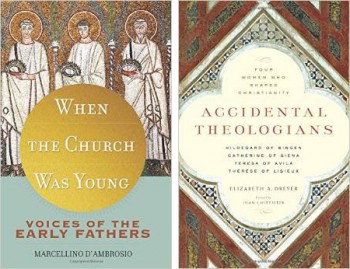 “When the Church Was Young: Voices of the Early Fathers”
“When the Church Was Young: Voices of the Early Fathers”
by Marcellino D’Ambrosio.
Servant Books (Cincinnati, 2014).
320 pp., $19.99.
“Accidental Theologians: Four Women Who Shaped Christianity”
by Elizabeth A. Dreyer.
Franciscan Media (Cincinnati, 2014).
160 pp., $15.99.
These two books, about very different historical figures in church history, share certain characteristics.
The authors have impressive academic and professional accomplishments but write in a manner that is accessible to the general reader. Both books provide excellent introductions to the writings and the theological and historical context of significant Christian thinkers.
They suggest ways for how we can appropriate the insights (D’Ambrosio) and methods (Dreyer) of doing theology. And both books model respect and gratitude for tradition.
Dreyer studies four women doctors of the church — Sts. Hildegard of Bingen, Catherine of Siena, Teresa of Avila and Therese of Lisieux. “Without formal theological education, these four women relied more heavily on the promptings of the Holy Spirit, their innate intelligence, and their individual and communal experience,” she writes.
[hotblock]
Although they lived in radically different times, Dreyer finds striking similarities in the theological themes of these four women. They offer us an incarnational, prophetic spirituality that has deep resonance with our contemporary Christian anthropology. In exploring their teachings on sin, suffering and self-knowledge she suggests ways we can channel our own theological reflection.
“Accidental Theologians” is a work that can be studied, but it also glitters with insight and quotes that make it suitable spiritual reading. “Catherine loves to repeat that God is madly in love, even drunk, with love for creation. … Her language about the intimate closeness of God is as extreme as that about God’s awesome otherness.”
And there is Teresa’s growth in understanding her sinfulness: “Teresa seems to have discovered her sinfulness as a direct consequence of God’s love for her. Her experience of unmerited, gratuitous love opened her eyes to the ways she devalued, manipulated and diminished herself and others. She became attuned to the subtle ways in which her desire for goodness and reform could be tainted by selfishness.”
These women left a legacy that is particularly valuable today, when the work of theology — particularly by women theologians — is called into question by some members of the hierarchy. “Their incredibly strong wills and perseverance in spite of difficulty are based on their theology of God as magnanimous lover and giver of grace, and on their positive Christian anthropology,” Dreyer writes.
“When the Church Was Young” is an engaging introduction to the early church fathers. D’Ambrosio has an extraordinary command of the history he writes about, the period from A.D. 100 to 800.
He defines the church fathers as “those great Christian writers who passed on and clarified the teaching of the apostles. … The era of the church fathers begins where the original eyewitnesses leave off and carries us through the period of the first even great universal or ecumenical councils that hammered out the two most central issues in the Christian faith — how one God could be conceived of as three distinct persons and how Jesus could be both God and man.”
In D’Ambrosio’s skilled hands we watch the development of doctrine, not through abstract thought, but in the heat of theological, political and regional conflicts. Orthodoxy was defined against the excesses of heresy, but so was a theology of liturgy, structures of authority, and the selection of what to include in the scriptural canon. They were passionate men, not a few prone to anger and impatience but, under the guidance of the Holy Spirit, they crafted a theology and church polity of wise moderation.
Throughout the book he offers us compelling excerpts from the writings of the fathers, but nothing approaches the poignancy of the narratives of those gifted with the grace of martyrdom. “It cannot be something one presumptuously volunteers for, since it is impossible to accomplish by the power of natural zeal.”
These writings are part of the shared patrimony of both Eastern and Western Christianity and D’Ambrosio’s book is appropriate for this time, when ecumenical relationships are characterized by respect rather than enmity.
But above all it is a hopeful reminder that ours is not the only century to face theological conflict and division or the opposition of society.
Moreover, we can address these challenges with the gift of tradition, the lives, witness, and teachings of the holy men and women we meet in these two books.
***
Coming in 2015: “The Ancient Path: Old Lessons From the Church Fathers for a New Life Today” by John Michael Talbot with Mike Aquilina. Image Books (New York, 2015). 208 pp., $22.
***
Linner, a freelance writer and reviewer, has a master’s degree in theology from Weston Jesuit School of Theology.
PREVIOUS: Huge squishy robot steals the show in ‘Big Hero 6’
NEXT: ‘St. Vincent’ offers a grouchy, flawed man as a saint for today



Share this story